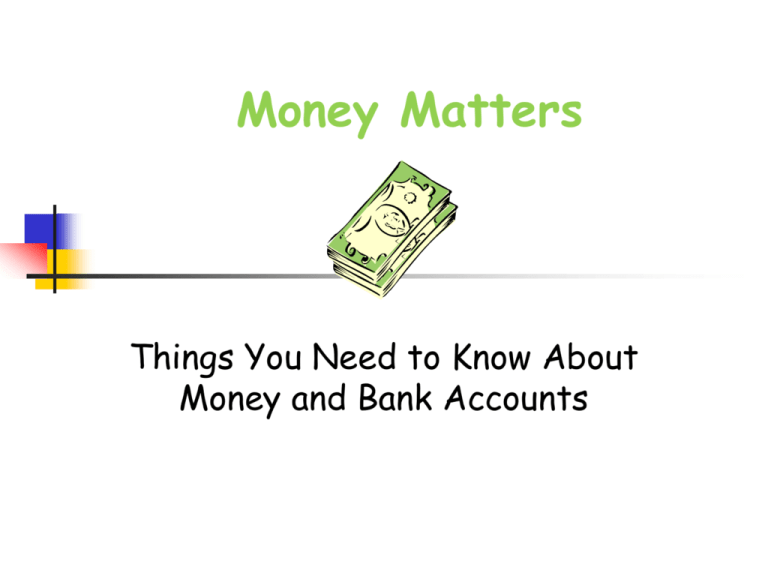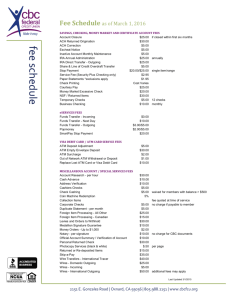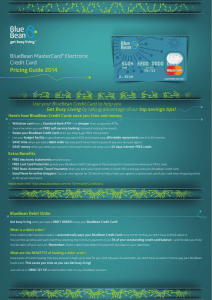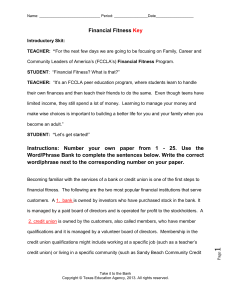Money Matters
advertisement

Money Matters Things You Need to Know About Money and Bank Accounts Paper Money American paper money in all denominations is the same color and the same size. One, 5, 10, 20, 50 and 100 dollar bills are most commonly used. Each bill will have a picture of a famous American on the front, and the bill's numerical denomination on each of the four front corners. You will have to be careful not to confuse the denominations. Coins American coins are even more confusing than currency notes. Nowhere on an American coin will you find a number value. For some reason, the amounts are spelled out. Nor are the coins minted in size order. Commonly used coins are the one-cent piece (penny), five-cent piece (nickel), ten-cent piece (dime) and 25-cent piece (quarter). Fifty-cent pieces are rarely seen. The penny is copper-colored and reads "one cent" on the bottom reverse. The nickel is a bit larger and reads "five cents" on the bottom reverse. The dime (10 cents) is the smallest coin, and, rather than "ten cents," reads "one dime." The quarter (25 cents) is larger than the other three coins and reads "quarter dollar" on the bottom reverse. Checking Account Allows you to write checks against your account, up to the available balance. If you don't have enough money in your account for a check you write, the check will "bounce" and the bank will return it unpaid to the person you wrote it to. You both will be charged an extra transaction fee (about $30). You'll use checks to pay for such items as rent, electric and telephone bills, insurance payments, mail-order goods, and so forth. You may often pay by check when shopping in person. If the store doesn't know you, they will want identification; usually at least one major national credit card plus a driver's license. Check Etiquette • Cash Back. It is not customary or polite to ask a merchant if you can write a check for more than the balance as a means to get ready cash, except, to a limited degree, in supermarkets. Supermarkets have special procedures for paying by check. You'll probably have to apply for a special check cashing card with the supermarket manager, and sometimes you'll have to get each check approved by the manager before you get in line with your purchases. The supermarket will have a limit ($25.00 or so) on how much cash you can get back above the amount of your purchase • Bouncing a Check. Not having money in the bank to cover a check you write is considered an embarrassment in the United States. If you bounce a check you write to a merchant, they will probably charge you an extra fee themselves easily accessed, not usually interest bearing Your Checking Account Your Checking Account 1. 2. 3. 4. 5. 6. Date: Write in the day you are filling out the check Pay to the Order of: Write in the name of the person(s) or place to whom you are writing the check $ Amount: Write the amount the check is for in Arabic numerals. When you write the number, start at the left and don't leave space. People could add in more numbers if you leave room Dollars: Write, in words, how much the check is for. When you write the words for the dollars, start at the left side. Write any cents as a fraction. Draw a line through the extra space Signature: Sign your name here, just like it is on the top of the check. Don't sign it until you use it. If you sign it ahead of time, someone else could use the check Memo: Indicate what the check payment is for (like “groceries”, “car payment”, or “rent January 2006”; it is also a good idea to write the account numbers associated with the bill you are paying.) Keep Track of Your Account Keep Track of Your Account 1. 2. 3. 4. 5. 6. 7. 8. Number: This is the check number. You'll find it in the upper right hand corner of each check. Every check has a different number. Date: Write in the date of the transaction. Description of Transaction: This tells what happened. Did you deposit money? Did you write a check? Use the Automated Teller Machine (ATM)? Make a telephone transfer? Describe your transaction here. Payment/ Debit: This is the amount of the check or how much the withdrawal is for. Code for Transaction: This is where you fill in a code for transactions you make when you aren't writing a check. When you get your statement, every month you'll place a "√" through this box if you see the transaction listed. Service Fee: If your financial institution charges you money to write each check, or to withdraw money from the ATM, write that fee in this space. Deposit/Credit: Did you deposit money into your account, does your statement say you earned interest? Write down the amount here. Balance: To find out how much money you have, add the deposited money to what you had before. Or subtract the withdrawal amount from what you had before. The money left is your balance. Keep Track of Your Account Balancing Your Checkbook Once a month, when you get your statement from the bank, go through the transaction record and make sure the statement matches your records. Did all the checks “go through”? Did you earn any interest or incur any fees you didn’t know about? Make sure all the numbers add up, and if they don’t, FIND OUT WHY! Automated Teller Machine Many banks offer automated teller machines (ATM's). These might be at your bank's branch, but the bank may also be a member of a network that will allow you to take money out or do certain transactions at hundreds of different machines at different banks. Some machines allow you to "drive-in" and use them without getting out of your car. Depending upon your bank and local regulations, you might pay a small fee for using an ATM. You will be given a plastic bank card and a secret access code number. You will place the card into the slot in the ATM then press in the access code numbers. The machine will only give you money if it matches the data from the card with the proper access code number. It is therefore very important to memorize your code number, or at least to keep it written down in a place separate from the bank card. If your bank card is stolen, the thief will not be able to use it to withdraw money from the ATM without the code number. The area around ATM machines is a popular place for thieves to rob unsuspecting people. ALWAYS be aware of your surroundings when using the ATM. If you see someone lurking outside, get back into your car. Debit Card/Check Card Look like credit cards or ATM cards, but act like cash or a personal check Debit/Check cards are “pay now”, Credit cards are “pay later” Is your ATM card also a Debit/Check Card? Look for the MasterCard or Visa logo ATM Cards are only good at Automatic Teller Machines Debit/Check Card Features Easier to get than a credit card Don’t have to give personal information to a vendor Don’t have to carry cash or a checkbook Can be used almost anywhere that accepts credit cards (most large merchants and lots of small ones) Sometimes accepted where paper checks aren’t Returning goods or canceling services purchase with a debit card is treated as if the purchase were made with cash or a check No “grace period” There may be less protection than with a credit card purchase for items which are never delivered, are defective, or were misrepresented. (You may dispute unauthorized charges or mistakes within 60 days, contact your bank if you cannot resolve the issue with the merchant) Financial Safety Report lost or stolen checks/cards to the bank immediately If you think someone else is using your debit/check or credit card number, report it to the bank immediately Hold on to your receipts! Someone can get the information they need to use your number from them Check your receipts against your bank statement Memorize your PIN (personal identification number) Never share a PIN Keep track of ALL your transactions in your check register Ask the bank what your financial responsibility is for a lost or stolen card (or number) if you report it within 2 days ($50 or less) Within 60 days ($500 or less) Over 60 days – you are responsible Never give personal information to someone on who calls you to “verify” your account information”








